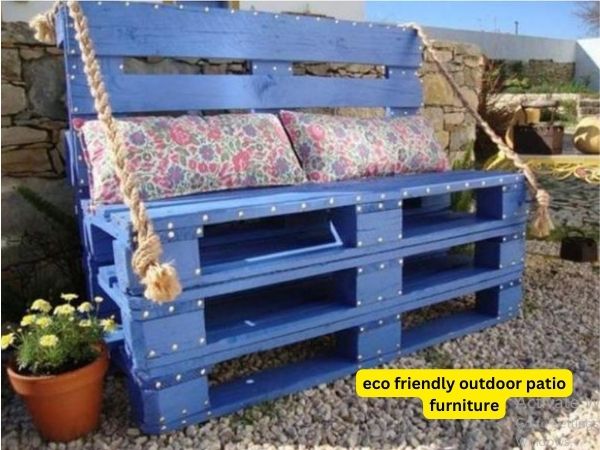Eco-Friendly Furniture Options For Sensory Processing Challenges
Are there any eco-friendly Furniture Options For Sensory Processing Challenges? The good news is, yes! Finding furniture that is both environmentally friendly and suitable for individuals with sensory processing challenges can be a challenge in itself, but fear not, there are solutions available.
The key lies in understanding the unique needs and sensitivities of those with sensory processing challenges and seeking out furniture that addresses these requirements while also being conscious of its impact on the planet.
In this article, we will explore some eco-friendly furniture options designed specifically for individuals with sensory processing challenges, ensuring both comfort and sustainability are achieved. Let’s dive in!
eco-friendly furniture options for people with sensory processing challenges
People with sensory processing challenges often have unique needs when it comes to their living environments. The right furniture choices can make a significant difference in their comfort and overall well-being. In recent years, there has been a growing awareness of the importance of eco-friendly options in furniture design. This article explores the availability of eco-friendly furniture options specifically tailored to meet the needs of individuals with sensory processing challenges. From materials to design considerations, we will delve into various aspects of incorporating sustainable and sensory-friendly furniture choices into your home or workspace.
1. Understanding Sensory Processing Challenges
Before exploring eco-friendly furniture options, it’s crucial to have a clear understanding of sensory processing challenges. Sensory processing refers to the way individuals perceive and respond to sensory information from their environment. For some people, their sensory systems may be over-responsive or under-responsive, impacting how they experience their surroundings.
Sensory Challenges and Furniture Selection
The furniture we choose can significantly impact individuals with sensory processing challenges. Some considerations include:
- Comfort: Choosing furniture pieces that offer exceptional comfort can provide a sense of security and relaxation.
- Texture: Selecting furniture with sensory-friendly textures can help individuals feel more at ease.
- Visual Overload: Minimizing visual clutter and choosing calming colors can create a more soothing environment.
- Acoustic Considerations: Reducing noise levels or incorporating sound-absorbing materials into furniture can be beneficial.
Benefits of Eco-Friendly Furniture
Eco-friendly furniture options offer numerous advantages for individuals with sensory processing challenges. These benefits include:
- Avoidance of Harmful Chemicals: Eco-friendly furniture is typically free from harmful toxins commonly found in traditional furniture, reducing the risk of triggering sensitivities.
- Sustainable Materials: Many eco-friendly furniture options are made from sustainable materials such as reclaimed wood, bamboo, or recycled plastic.
- Reduced Environmental Impact: Choosing eco-friendly furniture supports environmentally conscious practices, reducing the overall carbon footprint.
2. Eco-Friendly Materials for Sensory-Friendly Furniture
When it comes to selecting eco-friendly materials for sensory-friendly furniture, several options are worth considering. These materials offer a combination of sustainability and sensory-friendly characteristics.
Organic Cotton and Hemp Fabric
Organic cotton and hemp fabrics are popular choices for upholstery due to their softness and breathability. They are also eco-friendly, as they are grown without the use of harmful pesticides and chemicals. These natural materials can be soothing and gentle on the skin, making them ideal for individuals with sensory sensitivities.
Natural Latex Foam
Natural latex foam is a sustainable alternative to conventional foam often used in mattresses and cushions. It is derived from the sap of rubber trees and offers excellent comfort and support. Additionally, natural latex foam is hypoallergenic and resistant to dust mites and mold, benefiting individuals with allergies or sensitivities.
Bamboo
Bamboo is a versatile and sustainable material commonly used in furniture production. It is sturdy, lightweight, and known for its natural antibacterial properties. Bamboo furniture can be an excellent choice for individuals with sensory processing challenges as it offers a clean and hypoallergenic surface.
Reclaimed Wood
Reclaimed wood, sourced from old buildings, bridges, or other structures, is an eco-friendly option that adds character and uniqueness to furniture. Its natural textures and imperfections can be visually appealing while providing a tactile experience. Reclaimed wood is an ideal choice for those seeking sustainable and sensory-friendly furniture.
3. Ergonomic Design for Sensory-Friendly Furniture
In addition to sustainable materials, ergonomic design plays a crucial role in creating sensory-friendly furniture. Consider the following design elements:
Customizable and Modular Furniture
Customizable and modular furniture options allow individuals to adapt their living spaces to their specific needs. This flexibility enables the adjustment of furniture heights, angles, and configurations, promoting comfort and sensory regulation.
Soft Edges and Rounded Corners
Furniture with soft edges and rounded corners minimizes the risk of accidental bumps or injuries. This design feature ensures a safer environment, especially for individuals who may have difficulty with spatial awareness.
Weighted Furniture
Weighted furniture, such as chairs or blankets, can provide a calming effect for individuals with sensory processing challenges. The added pressure can offer a sense of security, helping to regulate their sensory systems.
Noise Reduction Features
Incorporating noise reduction features into furniture design is beneficial for individuals sensitive to auditory stimuli. Innovative solutions such as sound-absorbing materials or built-in acoustic panels can contribute to a quieter and more peaceful environment.
4. Sensory-Friendly Furniture for Different Settings
Sensory-friendly furniture options are not limited to residential spaces. They can also be incorporated into various settings to support individuals with sensory processing challenges. Let’s explore some examples:
Sensory-Friendly Furniture for Bedrooms
Creating a soothing bedroom environment is essential for restful sleep. Some sensory-friendly furniture options for bedrooms include:
- Orthopedic mattresses with natural latex foam for optimal comfort and support.
- Weighted blankets to provide a calming sensation and promote relaxation.
- Blackout curtains or blinds to minimize visual stimuli from outside.
Sensory-Friendly Furniture for Workspaces
Workspaces should be designed to minimize distractions and enhance focus. Consider the following sensory-friendly furniture options for work settings:
- Ergonomic chairs with adjustable features to support proper posture and reduce discomfort.
- Desk organizers or cable management systems to maintain a clutter-free workspace.
- Height-adjustable desks to accommodate different preferences and promote movement.
Sensory-Friendly Furniture for Common Areas
In common areas such as living rooms or lounges, incorporating sensory-friendly furniture is crucial for individuals to feel comfortable and at ease. Some options include:
- Sectional sofas with soft and supportive cushions for optimal relaxation.
- Bean bags or floor pillows for flexible seating options and a tactile experience.
- Natural fiber rugs for a soft and sensory-friendly texture underfoot.
5. Finding Eco-Friendly and Sensory-Friendly Furniture
When searching for eco-friendly and sensory-friendly furniture, keep the following tips in mind:
Research and Read Reviews
Before making a purchase, research various brands and read reviews from customers. Look for companies that prioritize sustainability and have positive feedback from individuals with sensory processing challenges.
Visit Local Sustainable Furniture Stores
Explore local sustainable furniture stores that specialize in eco-friendly options. Visiting in person allows you to experience the furniture firsthand and determine its sensory-friendly characteristics.
Online Marketplaces and Eco-Friendly Retailers
Online marketplaces and eco-friendly retailers often offer a wide selection of sustainable and sensory-friendly furniture. Take advantage of detailed product descriptions and customer reviews to make informed decisions.
Custom Furniture Solutions
Consider working with furniture designers or craftsmen who can create custom pieces tailored to your specific sensory needs. Custom solutions open up possibilities for unique, sustainable, and sensory-friendly furniture.
Frequently Asked Questions
Are there any eco-friendly furniture options for people with sensory processing challenges?
Yes, there are eco-friendly furniture options specifically designed for individuals with sensory processing challenges. These furniture options prioritize the comfort and well-being of individuals with sensory sensitivities.
What are some features to look for in eco-friendly furniture for sensory processing challenges?
When choosing eco-friendly furniture for sensory processing challenges, look for features such as hypoallergenic materials, non-toxic finishes, and ergonomic design to ensure maximum comfort and safety for individuals with sensory sensitivities.
Where can I find eco-friendly furniture for sensory processing challenges?
You can find eco-friendly furniture for sensory processing challenges at specialized stores that focus on inclusive furniture options. Additionally, there are online retailers that offer a wide range of eco-friendly furniture designed specifically for individuals with sensory sensitivities.
What are some examples of eco-friendly furniture options for sensory processing challenges?
Examples of eco-friendly furniture options for sensory processing challenges include sensory-friendly chairs with removable and washable covers, adjustable height desks with calming colors, and noise-canceling curtains made from sustainable materials. These options promote comfort and create a soothing environment for individuals with sensory sensitivities.
Can eco-friendly furniture for sensory processing challenges be personalized?
Yes, many eco-friendly furniture options for sensory processing challenges can be personalized. They often come with adjustable features such as height, angle, or firmness to cater to individual needs and preferences. Some manufacturers even offer customization options to ensure the furniture meets specific sensory requirements.
Are there any eco-friendly furniture options suitable for children with sensory processing challenges?
Absolutely! There are eco-friendly furniture options specially designed for children with sensory processing challenges. These may include sensory-friendly chairs, soft seating areas, and play furniture made from non-toxic and sustainable materials. These options provide a safe and comfortable space for children to relax and engage their senses.
Final Thoughts
In conclusion, there are indeed eco-friendly furniture options available for individuals with sensory processing challenges. These options prioritize both the well-being of the environment and the sensory needs of individuals, ensuring a harmonious balance between sustainability and functionality. From furniture made with organic and natural materials to pieces designed specifically to accommodate sensory needs, individuals with sensory processing challenges can enjoy a variety of eco-friendly options. By considering these alternatives, we can create inclusive and environmentally conscious spaces that promote comfort, well-being, and sustainability for all. Are there any eco-friendly furniture options for people with sensory processing challenges? Absolutely, and they offer a promising solution for a more inclusive and environmentally responsible future.



